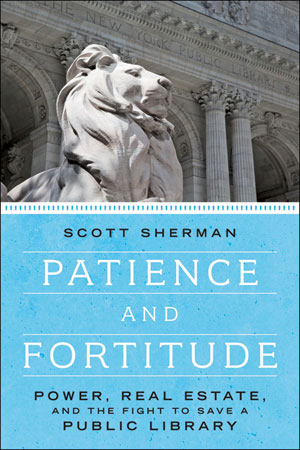A historic-preservation battle over Carr're and Hastings's 1911 marble palace for the New York Public Library is the subject of Scott Sherman's Patience and Fortitude: Power, Real Estate, and the Fight to Save a Public Library. The title's grandiosity is somewhat misleading: at no time was the landmark's exterior or its public spaces endangered by a controversial consolidation plan. Yet the battle over the main branch of the New York Public Library, which rises majestically along two city blocks behind a pair of stone lions (the Patience and Fortitude of the title) raises tough historic-preservation questions: What is essential to a great building's integrity? What should be done when money is not avail-able to maintain treasured resources?
As is rare for big-city libraries, the system's headquarters is almost entirely devoted to research. A Central Library Plan, devised in 2007, threatened that status, as trustees cooked up a complicated real-estate deal to shore up the institution's deteriorating finances. The idea was to close and sell two nearby branches, which sit on highly valuable midtown-Manhattan plots, and insert their consolidated functions into a new circulating library. And the architectural plan for the library's interior, as designed by Foster + Partners, would have replaced the main building's book stacks, which feed the spectacular Rose Reading room, a football-field long cathedral beloved by writers and researchers.
Selling public assets to underwrite failing public services is a time-honored fiscal gimmick in New York. The deals, however, are complicated and opaque; projects sold as 'free' to the public end up requiring large injections of public funds. The book chronicles the unraveling of the library's unholy deal.
The story is not so much about power as the hubris of wealthy trustees who worked in secret and ignored the evidence of the project's risk. That risk stared them in the face in the form of a 2007 sale of the busy Donnell branch to a developer. The deal promptly went south as the economy imploded. A second buyer ultimately took over and has left space for the branch, designed by TEN Arquitectos, within a 50-story tower. The library says the branch will open late this year, three years later than promised.
As for the main library on 42nd Street, scholars were infuriated that 1.2 million books from the stacks would be shipped to off-site storage. Foster's design had library floors opening to a full-height atrium. Its flimsy references to Henri Labrouste's great Biblioth'que Nationale in Paris were justly jeered at. A blistering critique on December 3, 2012, by Ada Louise Huxtable'her last column before her death weeks later'signaled the beginning of the end. Given that proceeds from the branches' sale (estimated at $200 million) might fall short, and Foster's $300 million design might have gone over budget, the project could have obligated the library to hundreds of millions in unanticipated costs when it would at best have offered $7 million in annual operational savings.
Much of the book describes the struggle to stop the project by preservationists concerned with historical integrity and scholars who saw the library dumping printed documents. Charles Warren, an architect and Carr're and Hastings scholar, argued eloquently that the ornate iron stacks were essential to the architectural conception: 'The building is a machine for reading books in . . . The books . . . rise up out of that machine into the reading room to serve the people.' He also noted that the stacks aren't furniture but structure, making their removal painstaking and costly.
The scholars were criticized as elitists for trying to hold onto the vast building primarily for research. Given its fiscal distress, the library had no choice but to consider how many volumes it needed to store on some of the most valuable real estate in the world. The library did a terrible job of framing this essential debate, while downsizing the very staff that had the expertise to help set priorities.
The opponents ultimately won: the library withdrew the plan last year. But it has removed the books from the historic stacks and is building at least some new ones under Bryant Park. It must still develop a full plan for the historic stacks. Meanwhile, it will renovate the Mid-Manhattan branch, keeping it as a circulating library.
Sherman's most shocking revelation is how little the trustees understood the mission of the institution they claimed to be saving.
James S. Russell writes for many publications and blogs at jamessrussell.net.


Post a comment to this article
Report Abusive Comment